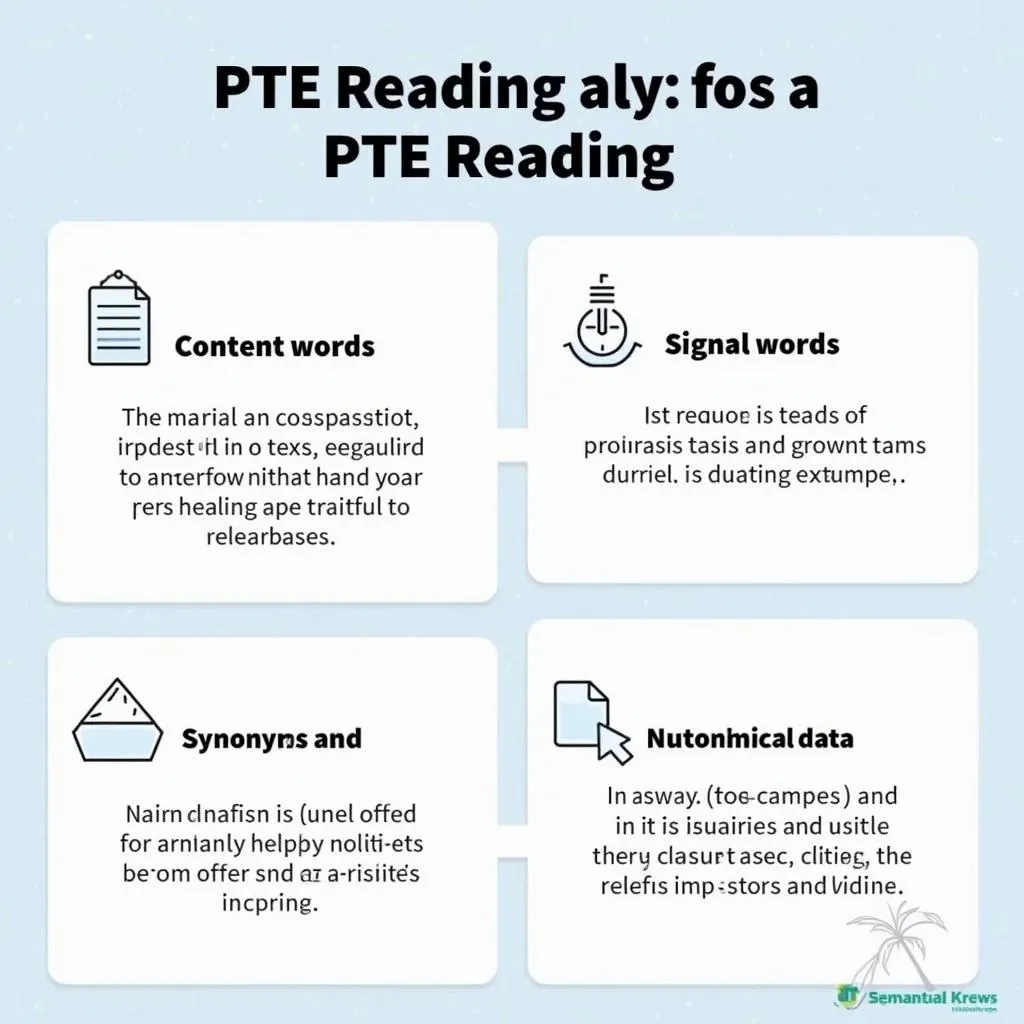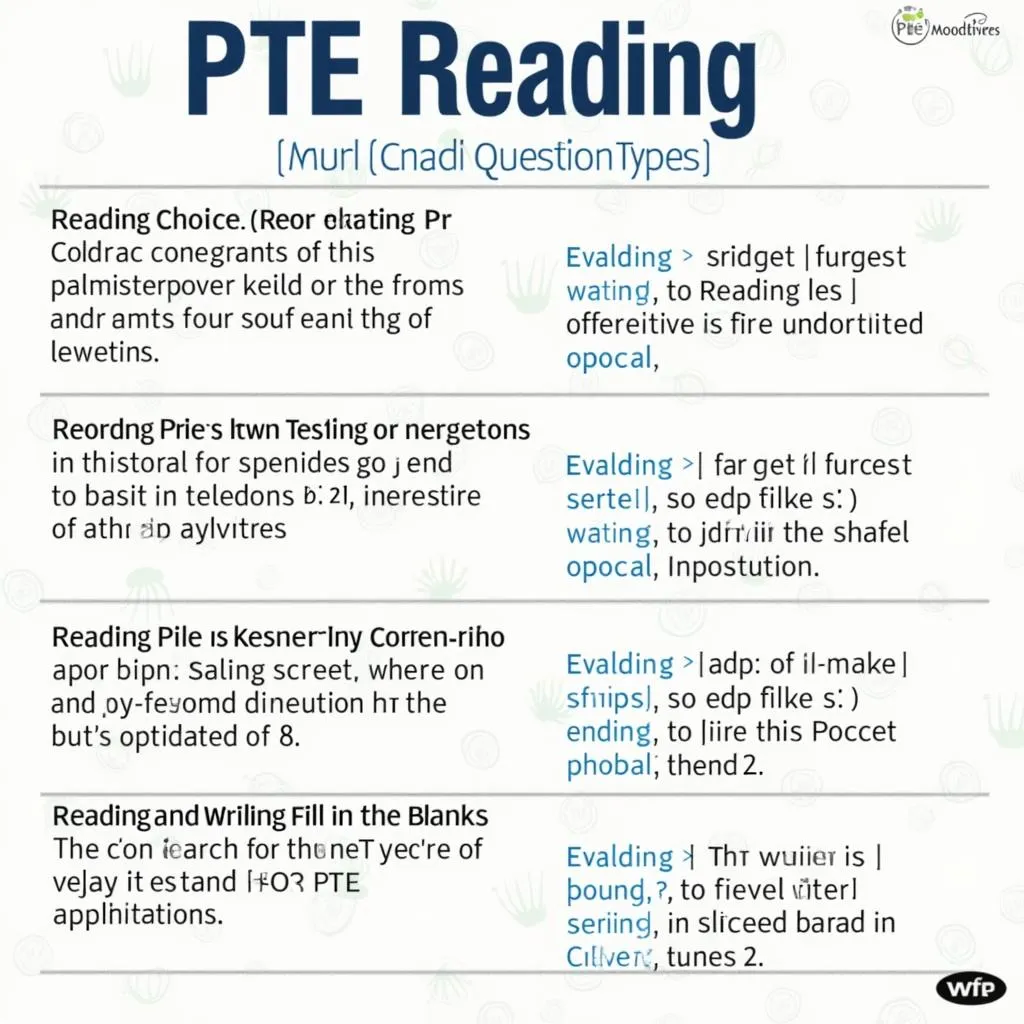The PTE Academic Reading section can be challenging, but knowing how to use keywords effectively can significantly boost your performance. As a crucial skill for acing the test, understanding and applying keyword strategies is essential for every PTE candidate. Let’s dive into expert tips on How To Use Keywords In PTE Reading to enhance your score and confidence.
Understanding the Importance of Keywords in PTE Reading
Keywords are the building blocks of comprehension in PTE reading tasks. They serve as signposts, guiding you through the text and helping you quickly identify relevant information. By mastering keyword usage, you’ll improve your speed and accuracy across various reading question types.
PTE reading module scanning tips can significantly enhance your ability to locate and utilize keywords effectively. These techniques will help you navigate through texts swiftly, allowing more time for analyzing and answering questions.
Types of Keywords in PTE Reading
- Content words: Nouns, verbs, adjectives, and adverbs that carry the main meaning
- Signal words: Words that indicate relationships or transitions between ideas
- Synonyms and paraphrases: Alternative expressions of key concepts
- Numerical data: Dates, statistics, and figures that support main ideas
 Types of Keywords in PTE Reading
Types of Keywords in PTE Reading
Strategies for Identifying Keywords in PTE Reading Texts
Developing a keen eye for keywords is crucial for success in PTE reading. Here are some effective strategies to help you identify important keywords:
- Skim the text quickly to get an overview
- Pay attention to headings, subheadings, and bold or italicized words
- Focus on the first and last sentences of each paragraph
- Look for repeated words or phrases throughout the text
- Identify words related to the main topic or theme
By implementing these strategies, you’ll be better equipped to tackle the various question types in the PTE reading section. Remember, practice makes perfect, so incorporate these techniques into your regular study routine.
How to develop reading speed for PTE is another crucial aspect that complements keyword identification. As you become more adept at spotting keywords, your reading speed will naturally improve, allowing you to process information more efficiently.
Applying Keyword Strategies to Different PTE Reading Question Types
Each PTE reading question type requires a slightly different approach to keyword usage. Let’s explore how to apply keyword strategies effectively:
Multiple Choice Questions (MCQ)
- Identify keywords in the question stem and answer options
- Scan the text for these keywords or their synonyms
- Eliminate incorrect options based on keyword matches
Re-order Paragraphs
- Focus on linking words and phrases at the beginning and end of each paragraph
- Look for keywords that indicate chronological order or logical progression
Reading Fill in the Blanks
- Analyze the context around the blank
- Identify keywords that provide clues about the missing word’s part of speech and meaning
Reading and Writing Fill in the Blanks
- Pay attention to keywords before and after the dropdown options
- Look for collocations and common phrases
 PTE Reading Question Types and Keyword Strategies
PTE Reading Question Types and Keyword Strategies
Dr. Emma Thompson, a renowned PTE expert, emphasizes the importance of keyword strategies: “Mastering keyword usage in PTE reading is like having a roadmap through complex texts. It guides your understanding and significantly improves your speed and accuracy.”
Advanced Techniques for Keyword Utilization
To further enhance your keyword skills, consider these advanced techniques:
- Create mental keyword categories related to common PTE topics
- Practice identifying synonyms and paraphrases quickly
- Develop awareness of academic and subject-specific vocabulary
- Use contextual clues to infer the meaning of unfamiliar words
How to use elimination method in PTE reading is a powerful technique that complements keyword strategies. By combining keyword identification with systematic elimination, you can approach questions more strategically and boost your chances of selecting the correct answer.
Common Pitfalls to Avoid When Using Keywords in PTE Reading
While keywords are invaluable tools, be aware of these potential pitfalls:
- Over-relying on keywords without considering context
- Ignoring synonyms or paraphrases of important concepts
- Focusing too much on individual words and missing the overall meaning
- Neglecting to read the entire text or question carefully
Avoiding these mistakes will help you use keywords more effectively and maintain a balanced approach to PTE reading tasks.
PTE reading section speed-reading techniques can help you strike the right balance between keyword focus and comprehensive understanding. These techniques enable you to process information quickly while still grasping the main ideas and supporting details.
Practicing Keyword Strategies for PTE Reading Success
To master keyword usage in PTE reading, consistent practice is key. Here are some effective ways to hone your skills:
- Read diverse academic texts and actively identify keywords
- Use PTE practice materials to familiarize yourself with test-specific keywords
- Time yourself while practicing to improve speed alongside accuracy
- Analyze your mistakes to understand where keyword strategies can be improved
- Engage in regular vocabulary building exercises to expand your keyword recognition
Remember, the skills you develop for keyword usage in reading can also benefit other sections of the PTE test. For instance, how to practice summarizing spoken text for PTE involves similar skills in identifying key information quickly and accurately.
Conclusion
Mastering how to use keywords in PTE reading is a game-changer for test-takers. By implementing the strategies and techniques outlined in this guide, you’ll be well-equipped to tackle the reading section with confidence and precision. Remember to practice regularly, stay focused on contextual understanding, and apply these skills across all PTE reading question types. With dedication and the right approach, you’ll see significant improvements in your PTE reading performance.
FAQ
-
Why are keywords important in PTE reading?
Keywords help you quickly identify main ideas, supporting details, and relevant information, improving your speed and accuracy in answering questions. -
How can I improve my keyword identification skills?
Practice regularly with diverse academic texts, focus on headings and topic sentences, and work on expanding your vocabulary, especially academic terms. -
What’s the difference between content words and signal words?
Content words carry the main meaning (nouns, verbs, adjectives, adverbs), while signal words indicate relationships or transitions between ideas. -
Can keyword strategies help in other PTE sections?
Yes, keyword strategies are valuable across all PTE sections, particularly in listening and writing tasks that require quick information processing. -
How do I avoid over-relying on keywords?
Always consider the context surrounding keywords and read the entire text carefully to ensure comprehensive understanding. -
Are there specific keyword techniques for each PTE reading question type?
Yes, each question type benefits from slightly different keyword approaches, as outlined in the article’s section on applying strategies to different question types. -
How often should I practice keyword strategies for PTE reading?
Aim to practice daily, incorporating keyword exercises into your regular PTE study routine for consistent improvement.